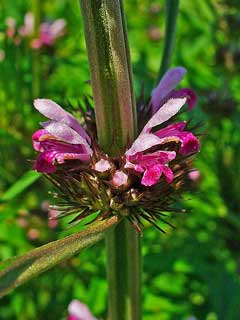 |
|
http://commons.wikimedia.org/wiki/User:Llez |
 |
| http://commons.wikimedia.org/wiki/User:Llez |
Translate this page:
Summary
Physical Characteristics

 Leonurus sibiricus is a ANNUAL/BIENNIAL growing to 1 m (3ft 3in) by 0.6 m (2ft).
Leonurus sibiricus is a ANNUAL/BIENNIAL growing to 1 m (3ft 3in) by 0.6 m (2ft).
See above for USDA hardiness. It is hardy to UK zone 6. It is in flower from July to September, and the seeds ripen in September. The species is hermaphrodite (has both male and female organs) and is pollinated by Bees.
Suitable for: light (sandy), medium (loamy) and heavy (clay) soils. Suitable pH: mildly acid, neutral and basic (mildly alkaline) soils. It can grow in semi-shade (light woodland) or no shade. It prefers moist soil.
UK Hardiness Map
US Hardiness Map
Synonyms
Plant Habitats
Cultivated Beds;
Edible Uses
Edible Parts: Leaves Root Shoots
Edible Uses:
Young shoots - cooked[105, 177, 183]. A sweetish flavour[179]. Root - cooked with other foods[177, 183]. This probably means that it is used as a flavouring[K].
References More on Edible Uses
Medicinal Uses
Plants For A Future can not take any responsibility for any adverse effects from the use of plants. Always seek advice from a professional before using a plant medicinally.
Antibacterial Antispasmodic Astringent Cardiac Depurative Diaphoretic Diuretic Eczema
Emmenagogue Hypnotic Nervine Oxytoxic Stimulant Stomachic Tonic
Chinese motherwort is unusual amongst Chinese herbs in that it is often prescribed for use on its own and not in a mixture with other plants[238]. The whole plant is antibacterial, antispasmodic, astringent, cardiac, depurative, diaphoretic, diuretic, emmenagogue, hypnotic, nervine, oxytocic, stomachic, tonic, uterine stimulant[4, 9, 21, 46, 165, 174, 178, 192, 279]. The seeds have a similar action to the plant, but are a less effective diuretic and depurative[238]. The plant is used in the treatment of painful and excessive menstruation, post-partum bleeding, oedema, kidney complaints, kidney stones, eczema and abscesses[238, 240]. A tincture is used in the treatment of rheumatic fever[192]. The plant stimulates uterine contractions and should not therefore be used when in the earlier stages of pregnancy[240]. The plant is harvested when in flower but before the seeds have set, and is dried for later use[238]. The plant contains about 0.05% of an alkaloid called leonurine[240]. This has a curare-like effect on the motor-endings of the nervous system, acting in small doses as a stimulant to the respiratory system but in large doses causing respiratory paralysis[240].
References More on Medicinal Uses
The Bookshop: Edible Plant Books
Our Latest books on Perennial Plants For Food Forests and Permaculture Gardens in paperback or digital formats.

Edible Tropical Plants
Food Forest Plants for Hotter Conditions: 250+ Plants For Tropical Food Forests & Permaculture Gardens.
More

Edible Temperate Plants
Plants for Your Food Forest: 500 Plants for Temperate Food Forests & Permaculture Gardens.
More

More Books
PFAF have eight books available in paperback and digital formats. Browse the shop for more information.
Shop Now
Other Uses
References More on Other Uses
Cultivation details
Prefers a well-drained moist soil in sun or partial shade[238]. Prefers a poor soil[108]. Plants are hardy to at least -15°c[238]. There is some confusion over the correct name for this species, it should quite probably be called L. japonicus.
References Carbon Farming Information and Carbon Sequestration Information
Temperature Converter
Type a value in the Celsius field to convert the value to Fahrenheit:
Fahrenheit:
The PFAF Bookshop
Plants For A Future have a number of books available in paperback and digital form. Book titles include Edible Plants, Edible Perennials, Edible Trees,Edible Shrubs, Woodland Gardening, and Temperate Food Forest Plants. Our new book is Food Forest Plants For Hotter Conditions (Tropical and Sub-Tropical).
Shop Now
Plant Propagation
Seed - sow late spring in a cold frame. When they are large enough to handle, prick the seedlings out into individual pots and plant them out in the summer.
Other Names
If available other names are mentioned here
Native Range
TEMPERATE ASIA: Russian Federation-Eastern Siberia (Eastern Siberia (Dauria)), Russian Federation (Altay), Mongolia, China (Hebei Sheng, Nei Mongol Zizhiqu, Shaanxi Sheng, Shanxi Sheng)
Weed Potential
Right plant wrong place. We are currently updating this section.
Please note that a plant may be invasive in one area but may not in your area so it's worth checking.
Conservation Status
IUCN Red List of Threatened Plants Status :

Growth: S = slow M = medium F = fast. Soil: L = light (sandy) M = medium H = heavy (clay). pH: A = acid N = neutral B = basic (alkaline). Shade: F = full shade S = semi-shade N = no shade. Moisture: D = dry M = Moist We = wet Wa = water.
Now available:
Food Forest Plants for Mediterranean Conditions
350+ Perennial Plants For Mediterranean and Drier Food Forests and Permaculture Gardens.
[Paperback and eBook]
This is the third in Plants For A Future's series of plant guides for food forests tailored to
specific climate zones. Following volumes on temperate and tropical ecosystems, this book focuses
on species suited to Mediterranean conditions—regions with hot, dry summers and cool, wet winters,
often facing the added challenge of climate change.
Read More
Expert comment
Author
L.
Botanical References
5874266
Links / References
For a list of references used on this page please go here
Readers comment
© 2010, Plants For A Future. Plants For A Future is a charitable company limited by guarantee, registered in England and Wales. Charity No. 1057719, Company No. 3204567.